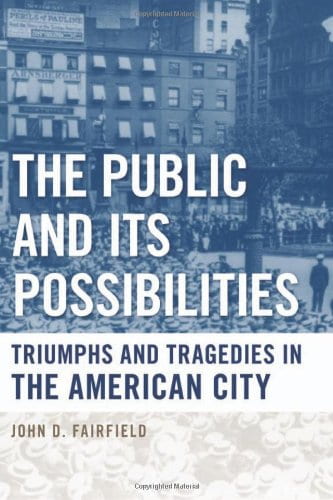By Daniel London
The capacity to live with difference is, in my view, the coming question of the twenty-first century.
The problem of solidarity is shaping up to be the problem of the 21st century.
Arthur M. Schlesinger Sr. inaugurated the field of American urban history in 1940 with a sweeping declaration that most of what was most progressive about America originated in cities. This was a result, he believed, of the circumscribed conditions within cities which “forced attention to matters of common concern which could not be ignored even by a people individualistically inclined.” This forcing of attention, in turn, brought with it a “necessary concern with the general welfare” that “nourished a sense of social responsibility”, manifested in collective voluntary action and, ultimately, in the welfare state.
While this interpretation still finds its defenders 60 years later by some unreconstructed social democrats, more specialized scholars of the American welfare state have not echoed it, to put it lightly. Rather than the result of a bottom-up solidaristic consensus or pragmatically pluralist negotiations, the welfare state as described in the work of such luminaries as Michael Katz and Linda Gordon represents the triumph of particular and privileged social groups (white men, mostly), the operations of which were lodged in bureaucracies disconnected from the people they were meant to serve. There is no talk of ‘public good’ in these works, at least with a straight face; rather, the American welfare state is characterized by its uneven and private-sector oriented nature, and its cities permanently characterized by fragmentation and segregation.
Both sets of interpretations, apparently irreconcilable, nonetheless rest on a similar set of over-drawn binaries between ‘public’ and ‘private’ as related to normative concepts (the public versus the private good), social groupings (civil society versus the state) and social provision (public sector versus the private sector). Here I would argue for a more open-ended, nuanced, and empirical research agenda as to the relations within and across these pairings, oriented around the concept of “public culture” articulated by Thomas Bender.
The welfare state was, for postwar social theorist and economist T.H. Marshall, the quintessential public good – an enrichment of the “universal status of citizenship” that both emerged from and ensured a “common culture and common experience” among the populace. Many urban historians sympathetic to this interpretation emphasize moments (and spaces) of communication and cooperation between social groups, tracking the rise of a progressive and redistributive Gemeinschaft that transcended, if not replaced, a more ethnos-oriented Gesellschaft.
Other historical works, however, argue that the idea of a “public good” was not only debilitating toward efforts at redistribution (usually via hegemonic interpretations), but that it overshadowed injustices oriented around what Nancy Fraser calls issues of recognition wherein gender and racial differences need to be stressed. Such battles over representation and multiculturalism, of course, are seen by social democrats as displacing attention from mal-distribution by failing to address its real causes, and undermining the solidarity that redistributive campaigns appear to require.
We need to move away from such zero-sum interpretations, and provide more historical accounts of how understandings of the public good were developed, articulated, and gained ideological and political purchase within and across different social groupings. To what extent do policies recognizing social differences (including those of class, race, and gender) inhibit trust, and empathy and cooperation between groups – and vice-versa? When, precisely, do languages and practices around solidarity – both in terms of cultural identifications and more abstract “interests” – weaken or strengthen the respective influence of different social institutions (civil society/state) and sectors (market/state) vis-à-vis one another?
T.H. Marshall also posited a unidirectional link between active “social responsibility” by citizens on the ground and the formations and operations of the Welfare State. Indeed, Marshall believed that at a certain point civil-society institutions such as unions would be unnecessary and distracting: it would be the State that ensured the common good free of any particularizing institutions. Conversely, Jürgen Habermas, believed that the welfare state actually destroyed the “public sphere” by making civil society seemingly unnecessary, thereby reducing citizens to State clients and eroding the zones of privacy – Nancy Fraser calls them “ ‘counter-publics’” – in which citizens can gain clearer and more participatory understanding of their interests.
More empirical work is needed investigating precisely when state organizations (and at what scale) are actually more open to inclusive and open participation than voluntary organizations. A more vexed problem, however, is examining degrees of overlap and connection between civil society organizations, communities, and state organizations. To what extent have diverse publics contributed to more general formation of public opinion on a scale sufficient to influence the state and other social institutions? How have transformations in the ownership and usage of communication – and the physical spaces where inter-group communication literally takes place – influenced their capacities to do so? How have ideas and policies around the ‘public value’ of redistribution and recognition been influenced by changing connections between, and degree of democracy within, these institutions? Finally, how have languages and practices around solidarity and conflict discussed earlier influenced participation within and across civil society and the state?
Finally, we must address the question of policies themselves. The entire point of Welfare, for Schlesinger and Marshall, was to ensure a certain equality of condition and opportunity for individuals that alternative mechanisms – the family, volunteer organizations, and especially the market – could not provide. America represents a “laggard” Welfare state, in the eyes of many historians, to the extent that these purportedly “private” institutions were responsible for sectors of social reproduction. Not only were such institutions insufficient in dealing with major economic crises, but they also discriminated on the basis of the recipients’ status or income in ways that universal, tax-financed policies (across class lines) do not. Other New Left and conservative critics argue that the State, by monopolizing social provision, erodes horizontal solidaristic ties within communities and civil society.
Recent scholarship into comparative welfare state formation, however, has overturned traditional understanding of the American State and welfare policy more generally. Most importantly for the purpose of this essay, they have demonstrated ‘public welfare’ activity always consists of a mixture of institutional players – many of them non-state – and policies at any given time. Under these conditions, how do individuals navigate changing configurations of welfare providers? How do differences in their funding structure (tax financed versus contributory), accessibility (means tested versus universal), and operation (via parochial organizations, civil-society, ‘community’ organizations, and so forth) both reflect and affect patterns of solidarity within and between groups?
As should be clear from this résumé, any simple characterization of the welfare state as either the embodiment or antithesis of solidarity rests on shaky foundations. The easy, unidirectional link between the “public” good”, the “public” sector, and “public” policies – as ultimately manifesting in the universal welfare state – does not seem born out by the evidence. However, both adherents of this position and its die-hard critics tended to state their cases in overly binary terms. This is partly an understandable reaction to the neoliberal valorization of the private sector since the 1970s. I also believe it stems, however, from the fact that so many historians tend to locate their areas of inquiry outside the realm of policy formation – preventing us from seeing in greater detail the actual inputs and effects of welfare policies on ideas, practices, and institutions as relating to solidarity.
Toward this end, I propose a research program scaffolded around the transformation and consequences of welfare policies (with “welfare” interpreted loosely), but whose locus of inquiry is what Thomas Bender calls the making of public culture. Public culture encompasses the sites and processes whereby social groups interact and contest for the power to define legitimate social meanings – in my own work, around the meanings of “public” and “private” – for the polity. This is not consensus or pluralist history, insofar as it critically examines how and why some groups and identities are not represented in these contests. It is, however, unapologetically built around interaction. Not as a way of avoiding questions of power and domination, but of more fully understanding and interrogating it: in Julian Zelizer’s words “how it was structured and changed, where it was contested what its impact was, and what assumptions shaped the discourse that framed it.” To this end, highlighting brief moments of social democratic deliberations or inter-group interactions is not enough: our study must also encompass the translation of (some) of these meanings into actual policies, along with their effects. If this entails a closer examination of institutional formations and interactions that many cultural historians have become accustomed to, so much the better.
What does all of this, finally, have to do with the city? We cannot naively assume that urban areas are, either historically or theoretically, the most generative space for social politics. However, they remain unparalleled as a site for investigating and comparing interactions at their most complex, heterogeneous, and dense. And in our investigations, we will need to deploy the methodologies of intellectual history in order to fully understand the contexts and complexes around the meaning of those keywords – public, private, solidarity, fragmentation – that are all-too-often unreflexively deployed by well-meaning commentators and chroniclers alike.





July 27, 2016 at 11:49 am
Interesting, Daniel! There’s also currently a revival of interest in the welfare state in British history, where it looms very large as definitional of the post-WWII social contract. I don’t know whether you’ve looked at that literature at all, but I’d be curious about whether you have any thoughts about how to compare it.